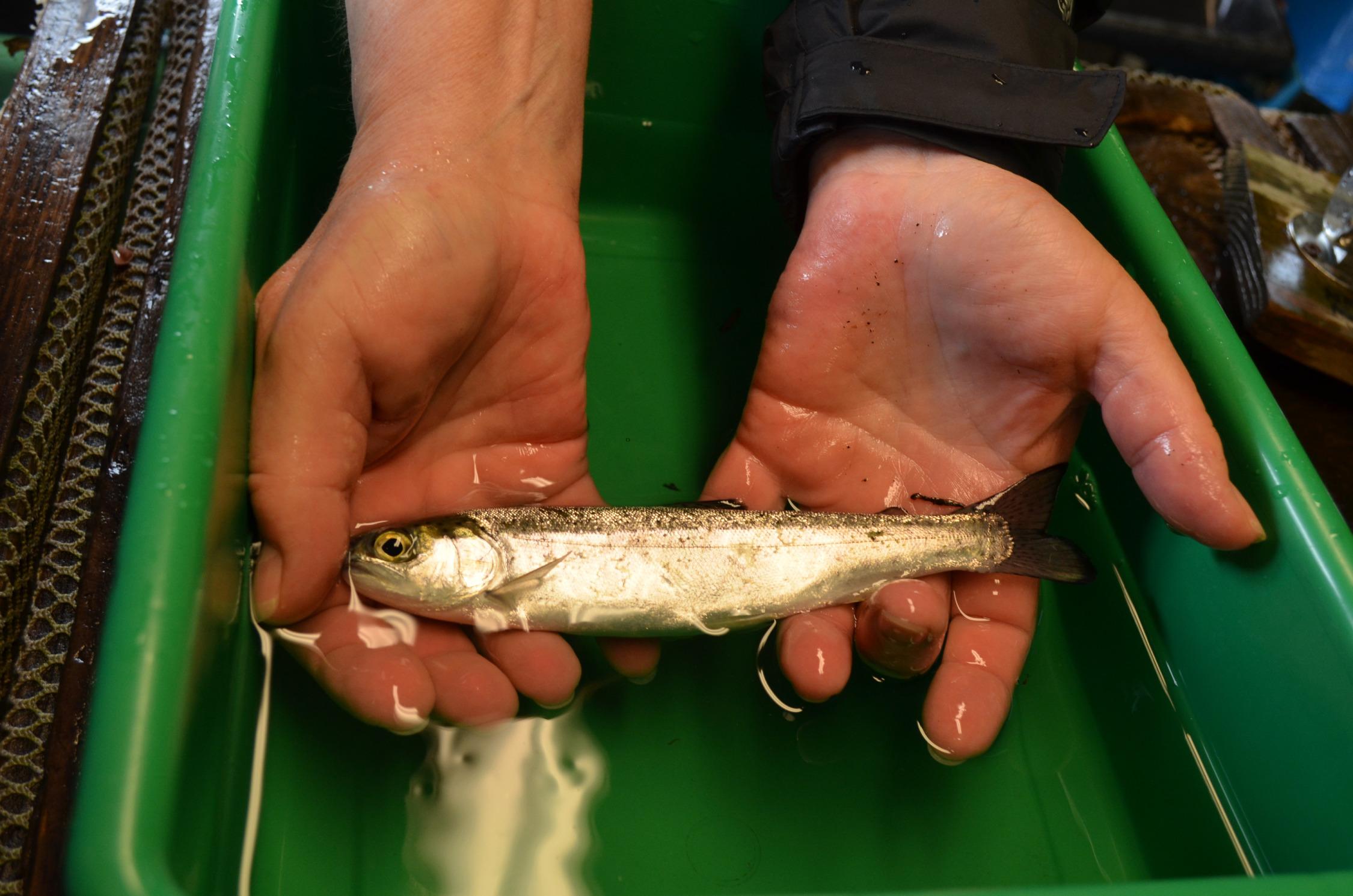
Karen Shields, with the Washington Department of Fish and Wildlife, shows a steelhead that she just caught on Big Beef Creek, which drains into Hood Canal.
Eilís O'Neill, KUOW / EarthFix
If you ever wanted to follow a steelhead from the stream it was born in to the open ocean, now you have your chance. There’s a new online game, called “Survive the Sound,” which is like Oregon Trail, except with real fish instead of computerized wagon trains.
And for a game with real fish to play out, scientists have to catch steelhead.
That's part of the job for fish biologist Clayton Kinsel. It’s late April and juvenile salmon and steelhead are rushing down the Big Beef Creek, a stream that empties out into Puget Sound’s Hood Canal. The smolts, as scientists call them, are trying to make it to the ocean.
The first big barrier they encounter is a weir, which is “like a temporary dam with removable panels,” explains Kinsel, who works for the Washington Department of Fish and Wildlife. “So, when the smolts are coming downstream, we’ll put the panels in and force them to swim downstream through our trap.”
In other words, “all the fish that are heading downstream to the ocean go into the fan traps and into a live box where we’re able to count them,” Kinsel says.
Most of those fish just get counted and then released. But not the steelhead.
That's because Puget Sound steelhead are declining more than many of Washington's other migratory fish. They've been listed as threatened since 2007.
NOAA fish biologist Megan Moore says she’s trying to figure out what’s killing steelhead so scientists can develop a plan for their recovery.
“We’ve been focused on trying to figure out what in the Puget Sound is causing declines in survival that are not necessarily the same problems that are experienced by coho or chinook,” Moore says.
That’s why this year, Moore is bringing 250 steelhead into the research station for surgery.

Megan Moore, a NOAA fisheries biologist, performs surgery on a steelhead to insert a tracking tag.
Eilís O'Neill, KUOW / EarthFix
Moore lifts each fish out of a tub of water, drops it into a solution that puts it to sleep, and then places it on the operating table. She makes an incision, inserts a tag, and closes the wound with two quick sutures. The whole operation takes just a few minutes.
Then, as the fish make their way out to the ocean, the tags let the scientists know where they are.
“When they’re migrating through, you can determine which fish has made it to which point,” Moore explains.
Normally, only scientists have the technology to track wildlife. But, now, the public can follow along by sponsoring fish--and racing other people’s fish--as the steelhead encounter barriers on their way out to the ocean.
“Between May 8 and May 19, you’ll be able to watch live on a map as your steelhead race for survival,” says Lucas Hall, with the organization “Long Live the Kings,” which is organizing the game.
The
is a real nail-biter, because most steelhead don’t make it. Some get stuck behind the Hood Canal Bridge. Others get eaten by harbor seals or other predators. Warming streams and lower summer flows have done in other juvenile fish.

A screenshot from the online game, Survive the Sound. Players can sponsor a steelhead and track its progress, or demise, en route through Puget Sound and on to the Pacific Ocean.
survivethesound.org
Two of the people playing the game are Ryan McFarland and his eight-year-old son Dylan. I met them at Ryan’s law firm in downtown Seattle, where Dylan sat at a computer to choose a steelhead.
“I saw a lot of steelhead fishes. I choose Jaws because I like the name,” Dylan explains. Then he adds: Jaws is little, and a fast, little fish is more likely to be able to dodge seals and seagulls.
Ryan says he takes his son out fishing most years, and he’d like to take him out to catch a steelhead someday. Right now, he can’t, because there just aren’t enough of them.
“It’s a good thing to talk to Dylan about and to understand, you know, right now four out of five fish will die,” Ryan says. “Part of the reason for the contest and the science is to try and increase the number of fish that make it out into the ocean.”
For the next two weeks, you, too, can choose a steelhead to track all the way to the ocean--that is, if it doesn’t get stuck at the Hood Canal Bridge, or eaten by a seal.

